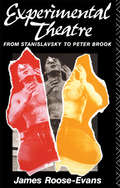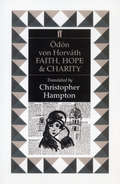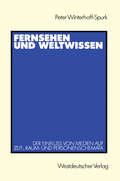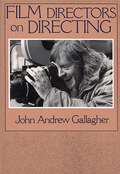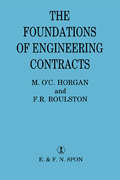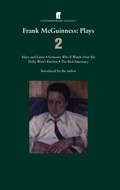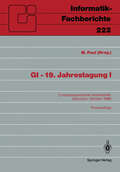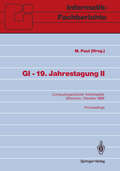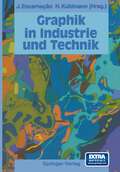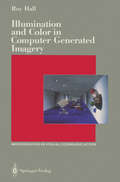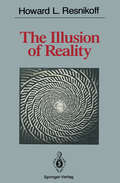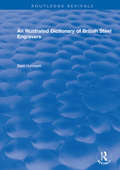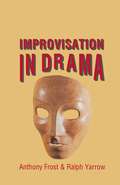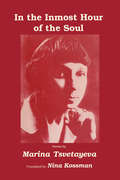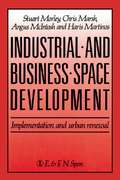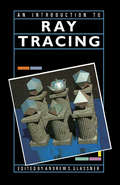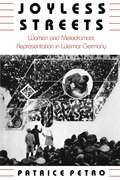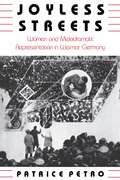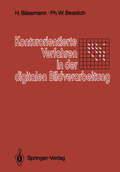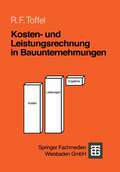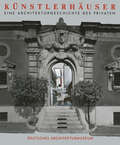- Table View
- List View
Experimental Theatre: From Stanislavsky to Peter Brook
by James Roose-Evans`It is a pleasure to read. Well-written, free of cant, impressively wide-ranging. The book is really an introduction to the avant-garde.' - John Lahr
Experimental Theatre: From Stanislavsky to Peter Brook
by James Roose-Evans`It is a pleasure to read. Well-written, free of cant, impressively wide-ranging. The book is really an introduction to the avant-garde.' - John Lahr
Faith, Hope and Charity
by Odon von HorvathSet in the socially and economically oppressed Vienna of the early thirties, this play is the story of a young girl's struggle to survive in the city, a victim of forces she does not comprehend. As the play opens, she is trying to sell her body to an anatomical institute.
Fernsehen und Weltwissen: Der Einfluß von Medien auf Zeit-, Raum- und Personenschemata
by Peter Winterhoff-SpurkFilm Directors on Directing
by John A. GallagherIndependent director and screenwriter John Andrew Gallagher, interviews 21 filmmakers on the craft of motion picture directing. Francois Truffaut, the late great French director, as well as Michael Cimino, Ulu Grosbard, Dennis Hopper, Alan Parker, Susan Seidelman, Joan Micklin Silver and many others reveal behind-the-scenes anecdotes about well known films and stars.The big gamblers who spend millions per film as well as the colorful low-budget kings provide an intriguing look at the mechanics of filmmaking. Choosing and preparing the screenplay, working with actors and crew, dealing with the distributor, and advice to young filmmakers--all are covered in this book's illuminating interviews. Serious students of cinema, filmmakers, movie buffs, and people fascinated by film will find Film Directors on in this book's illuminating interviews.
The Foundations of Engineering Contracts
by F R **Decd** M.O'C. Horgan F.R. RoulstonThis highly readable guide explains the main features of contracts applicable to the design, construction and servicing of civil, building, electrical or mechanical works. The emphasis throughout is on practical guidance, with clear explanations of the essential elements including legality, uncertainty, undue influence, agencies, overseas works, sub-contracts and quality assurance. Numerous appendices give common terms used in contracts, typical sets of standard conditions and further useful information. The book is particularly suitable for those new to the subject who will find practical guidance on understanding contracts in a wide range of civil engineering and construction works.
The Foundations of Engineering Contracts
by F R **Decd** M.O'C. Horgan F.R. RoulstonThis highly readable guide explains the main features of contracts applicable to the design, construction and servicing of civil, building, electrical or mechanical works. The emphasis throughout is on practical guidance, with clear explanations of the essential elements including legality, uncertainty, undue influence, agencies, overseas works, sub-contracts and quality assurance. Numerous appendices give common terms used in contracts, typical sets of standard conditions and further useful information. The book is particularly suitable for those new to the subject who will find practical guidance on understanding contracts in a wide range of civil engineering and construction works.
Frank McGuinness Plays 2: Mary and Lizzie; Someone Who'll Watch Over Me; Dolly West's Kitchen; The Bird Sanctuary
by Frank McGuinnessThis second collection of Frank McGuinness contains his beautifully lyrical plays from 1989 to 1999. The Bird Sanctuary is published here for the first time. The collection also includes Mary and Lizzie, Someone Who'll Watch Over Me and Dolly West's Kitchen, and is introduced by the author.
GI — 19. Jahrestagung I: Computergestützter Arbeitsplatz München, 18.–20. Oktober 1989 Proceedings (Informatik-Fachberichte #222)
by M. PaulDie in den vergangenen Jahren außerordentlich gesteigerte Leistungsfähigkeit sowohl der Arbeitsplatzrechner als auch der Kommunikationstechnik für ihre Vernetzung erschließen sinnvolle Anwendungsmöglichkeiten für immer weitere und umfangreichere Arbeitsbereiche. Die 19. Jahrestagung der GI greift wichtige Fragen hierzu auf und setzt sich mit einer Fülle von Einzelthemen auseinander. Dabei wendet sie sich gleichermaßen an Entwickler, Anwender, Wissenschaftler und Studenten.
GI — 19. Jahrestagung II: Computergestützter Arbeitsplatz München, 18.–20. Oktober 1989 (Informatik-Fachberichte #223)
by M. PaulDie in den vergangenen Jahren außerordentlich gesteigerte Leistungsfähigkeit sowohl der Arbeitsplatzrechner als auch der Kommunikationstechnik für ihre Vernetzung erschließen sinnvolle Anwendungsmöglichkeiten für immer weitere und umfangreichere Arbeitsbereiche. Die 19. Jahrestagung der GI greift wichtige Fragen hierzu auf und setzt sich mit einer Fülle von Einzelthemen auseinander. Dabei wendet sie sich gleichermaßen an Entwickler, Anwender, Wissenschaftler und Studenten.
Graphik in Industrie und Technik (Beiträge zur Graphischen Datenverarbeitung)
by Jose Encarnacao Karl H. Ditze Herbert W. Kuhlmann K. ZuseMit diesem anläßlich des 125jährigen Firmenjubiläums von ARISTO herausgegebenen Buch wird dem Leser ein detaillierter Einblick in die umfangreichen Aufgaben der Praxis vermittelt, in denen die Graphische Datenverarbeitung erfolgreich ihren Einzug genommen hat. Dabei wird von den ersten Anfängen bis zu modernsten Techniken anhand von Anwendungsgebieten beispielhaft dargestellt, welche Möglichkeiten bestehen, und wie diese sich in der Praxis auswirken. Anhand von praktischen Tätigkeitsfeldern soll dieses Buch zeigen, wie sich die Technik entwickelt hat, wo sie heute steht, und was für die Zukunft zu erwarten ist. Es leistet damit einen Beitrag zum Technologieverständnis und soll helfen, Hemmungen und Vorbehalte abzubauen.
Illumination and Color in Computer Generated Imagery (Monographs in Visual Communication)
by Roy HallIn a very broad sense the historical development of computer graphics can be considered in three phases, each a giant step down the road towards "realistic" computer generated images. The first, during the late 1960's and early 1970's, can perhaps be characterized as the "wire frame" era. Basically pictures were composed of lines. Considerable em phasis was placed on "real time" interactive manipulation of the model. As models became more complex and as raster technology developed, eliminating the hidden lines or hidden surfaces from the image became critical for visual understanding. This requirement resulted in the second phase of computer graphics, the "hidden surface" era, that developed during the 1970's and early 1980's. The names associated with hidden surface algorithms read like a who's who of computer graphics. The cul mination of the hidden surface era and the beginning of the current and third era in computer graphics, the "rendering" era, was Turner Whitted's incorporation of a global illumination model into the ray trac ing algorithm. Now the goal was not just to generate an image, but to generate a realistic appearing image.
The Illusion of Reality
by Howard L. ResnikoffThe Illusion of Reality was conceived during my tenure as director of the newly established Division of Information Science and Technology at the National Science Foundation in 1979-1981 as a partial response to the need for a textbook for students, both in and out of government, that would pro vide a comprehensive view of information science as a fundamental constitu ent of other more established disciplines with a unity and coherence distinct from computer science, cognitive science, and library science although it is related to all of them. Driven by the advances of information technology, the perception of information science has progressed rapidly: today it seems well understood that information processing biological organisms and informa tion processing electronic machines have something basic in common that may subsume the theory of computation, as well as fundamental parts of physics. This book is primarily intended as a text for an advanced undergraduate or a graduate introduction to information science. The multidisciplinary nature of the subject has naturally led to the inclusion of a considerable amount of background material in various fields. The reader is likely to fmd the treat ment relatively oversimplified in fields with which he is familiar and, perhaps, somewhat heavier sailing in less familiar waters. The theme of common principles among seemingly unrelated applications provides the connective tissue for the diverse topics covered in the text and, I hope, justifies the variable level of presentation. Some of the material appears here for the first time.
An Illustrated Dictionary of British Steel Engravers (Routledge Revivals)
by Basil HunnisettFirst published in 1989, An Illustrated Dictionary of British Steel Engravers contains more than 600 entries and an extensive plate section, providing examples of work referenced in the text and adding a clear chronological dimension to the subject. The book makes use of an array of surviving accounts and correspondence of engravers and publishers and adopts a comprehensive and systematic approach to identifying different types and variants of steel engravings over time. Equipped with a detailed introduction to the history of steel engravings, An Illustrated Dictionary of British Steel Engravers will be of great use to those interested in illustration, graphic art, Victorian literature, and the history of printing.
An Illustrated Dictionary of British Steel Engravers (Routledge Revivals)
by Basil HunnisettFirst published in 1989, An Illustrated Dictionary of British Steel Engravers contains more than 600 entries and an extensive plate section, providing examples of work referenced in the text and adding a clear chronological dimension to the subject. The book makes use of an array of surviving accounts and correspondence of engravers and publishers and adopts a comprehensive and systematic approach to identifying different types and variants of steel engravings over time. Equipped with a detailed introduction to the history of steel engravings, An Illustrated Dictionary of British Steel Engravers will be of great use to those interested in illustration, graphic art, Victorian literature, and the history of printing.
Improvisation in Drama (New Directions in Theatre)
by Anthony Frost Ralph YarrowImprovisation is fundamental to all drama as the skill of using various resources to suggest an idea, a situation, a character, perhaps even a text, but it is also a technique for rehearsal of social statement and much more. Following an introduction to the multiple notions of improvisation, the authors examine four main areas of contemporary improvisation work, offer case studies of major practitioners and draw conclusions regarding the theoretical implications of the earlier discussions to move toward an understanding of the creation of 'meaning' in action. This book offers thoughtful reading for actors, students of drama, academics, scholars and general readers.
In the Inmost Hour of the Soul (Vox Humana)
by Marina Tsvetayeva Nina Kossman" .. .1 have no love for life as such; for me it begins to have significance, i.e., to acquire meaning and weight, only when it is transformed, i.e., in art. If I were taken beyond the sea into paradise-and forbidden to write, I would refuse the sea and paradise. I don't need life as a thing in itself." This, written by Tsvetayeva in a letter to her Czech friend, Teskova, in 1925, could stand as an inscription to her life. Marina Tsvetayeva was born in Moscow on September 26, 1892. Her fathel~ a well-known art historian and philolo gist, founded the Moscow Museum of the Fine Arts, now known as the Pushkin Museum; her mother, a pianist, died young, in 1906. Marina began writing poetry at the age of six. Her first book, Evening Album, contained poems she had writ ten before she turned seventeen, and enjoyed reviews by the poet, painter, and mentor of young writers, Max Voloshin, the poet Gumilyov, and the Symbolist critic and poet, Valerii Bryusov. Voloshin and Gumilyov welcomed the seventeen year-old poet as their equal; Bryusov was more critical of her, though he too, in his own belligerent way, acknowledged her talent.
Industrial and Business Space Development: Implementation and urban renewal
by C. Marsh H. Martinos A. McIntosh S. MorelyAn insight into the changing nature of the industrial and business space property market and how business space development schemes can be initiated and implemented to revitalise urban areas.
Industrial and Business Space Development: Implementation and urban renewal
by C. Marsh H. Martinos A. McIntosh S. MorelyAn insight into the changing nature of the industrial and business space property market and how business space development schemes can be initiated and implemented to revitalise urban areas.
An Introduction to Ray Tracing (The Morgan Kaufmann Series in Computer Graphics)
by Andrew S. GlassnerThe creation of ever more realistic 3-D images is central to the development of computer graphics. The ray tracing technique has become one of the most popular and powerful means by which photo-realistic images can now be created. The simplicity, elegance and ease of implementation makes ray tracing an essential part of understanding and exploiting state-of-the-art computer graphics.An Introduction to Ray Tracing develops from fundamental principles to advanced applications, providing "how-to" procedures as well as a detailed understanding of the scientific foundations of ray tracing. It is also richly illustrated with four-color and black-and-white plates. This is a book which will be welcomed by all concerned with modern computer graphics, image processing, and computer-aided design.Provides practical "how-to" informationContains high quality color plates of images created using ray tracing techniquesProgresses from a basic understanding to the advanced science and application of ray tracing
Joyless Streets: Women and Melodramatic Representation in Weimar Germany
by Patrice PetroPatrice Petro challenges the conventional assessment of German film history, which sees classical films as responding solely to male anxieties and fears. Exploring the address made to women in melodramatic films and in popular illustrated magazines, she shows how Weimar Germany had a commercially viable female audience, fascinated with looking at images that called traditional representations of gender into question. Interdisciplinary in her approach, Petro interweaves archival research with recent theoretical debates to offer not merely another view of the Weimar cinema but also another way of looking at Weimar film culture. Women's modernity, she suggests, was not the same as men's modernism, and the image of the city street in film and photojournalism reveals how women responded differently from men to the political, economic, and psychic upheaval of their times.
Joyless Streets: Women and Melodramatic Representation in Weimar Germany
by Patrice PetroPatrice Petro challenges the conventional assessment of German film history, which sees classical films as responding solely to male anxieties and fears. Exploring the address made to women in melodramatic films and in popular illustrated magazines, she shows how Weimar Germany had a commercially viable female audience, fascinated with looking at images that called traditional representations of gender into question. Interdisciplinary in her approach, Petro interweaves archival research with recent theoretical debates to offer not merely another view of the Weimar cinema but also another way of looking at Weimar film culture. Women's modernity, she suggests, was not the same as men's modernism, and the image of the city street in film and photojournalism reveals how women responded differently from men to the political, economic, and psychic upheaval of their times.
Konturorientierte Verfahren in der digitalen Bildverarbeitung
by Henning Bässmann Philipp W. BesslichKosten- und Leistungsrechnung in Bauunternehmungen (Leitfaden des Baubetriebs und der Bauwirtschaft)
by Rolf F. ToffelDie Kosten- und Leistungsrechnung in Bauunternehmungen hat den Zweck, den betrieblichen Prozeß des Absatzes und der Erstellung von Bauleistungen zu planen und zu kontrollieren. Die drei typischen Merkmale der Bauunternehmung - die Einzelfertigung, die Auftragsfertigung und die Baustellenfertigung - machen eine typische Ausgestal tung der Kosten- und Leistungsrechnung in Bauunternehmungen erforderlich, in der nicht nur die Unternehmung insgesamt, sondern vor allem auch die einzelnen Bauobjekte mit Hilfe der Rechengrößen Kosten und Leistungen geplant und kontrolliert werden. Entsprechend wird hier hauptsächlich unterteilt in eine Kosten- und Leistungs rechnung für Einzelobjekte und eine solche für den Gesamtbetrieb. Diese Darstellung der Planung und Kontrolle der Kosten und Leistungen für Einzelobjekte und für den Gesamtbetrieb bedient sich der eingeführten und bewährten Begriffe des allgemeinen betriebswirtschaftlichen Rechnungswesens, soweit es möglich ist, und spezifischer baubetriebswirtschaftlicher Begriffe, wo es die Besonderheit des Baubetriebes nötig erscheinen läßt. Um dem Leser das Rechnen mit Kosten und Leistungen systematisch und auch für die praktische Anwendung gleichermaßen anschaulich nahe zu bringen, wird die Kosten- und Leistungsberechnung für Einzelobjekte und die für den Gesamt betrieb an jeweils einem Beispiel durchgängig verifiziert, und zwar ohne wie auch mit Einsatz der Elektronischen Datenverarbeitung.
Künstlerhäuser: Eine Architekturgeschichte des Privaten
by Hans-Peter Schwarzseape locus ingenio stimolos admovet. Petrarca Der Genius Loci, jene in den letzten Jahren durch Architekturkritik und Architekturtheorie so euphemistisch beschriebene "Besonderheit des Ortes", aus dessen Charakteristik eine sprachlos gewordene Architektur sich die Riickgewinnung verlorengegangener Anmutungsqualitaten er hofft, ist nirgendwo so deutlich spiirbar wie dort, wo durch gesellschaft liche Konvention geadelte Genies ihr kiinstlerisches, literarisches oder musikalisches Tagwerk verrichteten. Das "Vittoriale" Gabriele D' Annunzios ist so ein Wallfahrtsort fiir die Nachgeborenen, oder auch Richard Wagners "Wahnfried" und die Goethe-Hauser in Weimar oder Frankfurt, wobei es niemanden anficht, daB der hier besonders verehrte Olympier "sein" Geburtshaus erst im reifen Mannesalter und allenfalls besuchsweise kennengelernt haben diirfte. Aber die Authentizitat zu hinterfragen, eriibrigt sich fiir den Kultur touristen. Ihm geniigt es, topographische Fixpunkte zu haben, an denen das Stigma des Genialen zumindest in der Imagination wiederentdeckt werden kann. Kiinstlerhauser blieben zumeist Domane romantischer oder lokalpatriotischer Freizeitforscher, denen es weniger darauf an kam, das historisch exakte als das jeweils zeitgenossisch vermittelte Bild yom Kiinstler zu rekonstruieren. Dabei ist eine historische Auseinandersetzung mit den Hausern, die Kiinstler und Architekten fiir sich selbst entworfen und gebaut haben, mit deren Hilfe sie sich in der Gesellschaft eingerichtet oder von ihr abgegrenzt haben, gleich in mehrfacher Hinsicht von Bedeutung. Zum einen konnen wir davon ausgehen, daB gerade die professionellen "Astheten" bei der Einrichtung ihrer unmittelbaren Umgebung beson ders genau und besonders intensiv die Mittel benutzt haben, die Archi tektur, Skulptur und Malerei entwickelt haben, urn Ideen auszudriicken, urn aussagekraftig zu werden, urn gesellschaftliche Anspriiche zu stellen.
